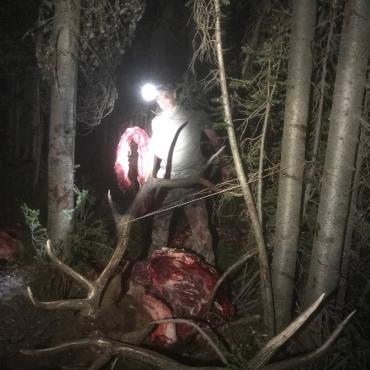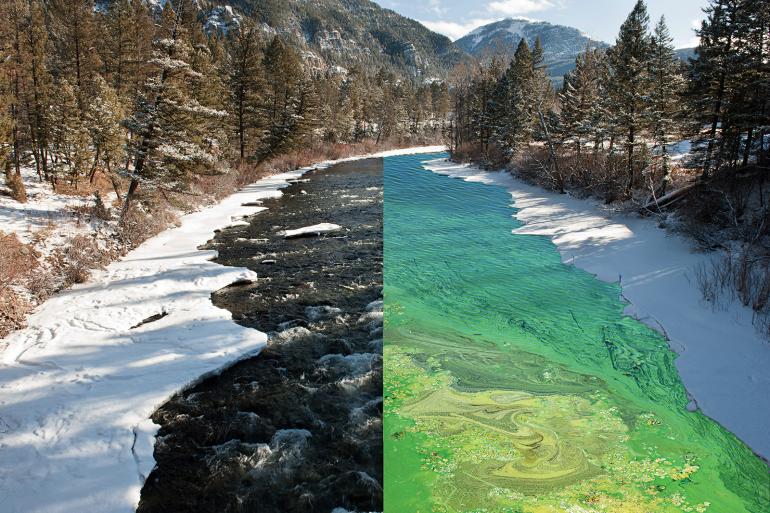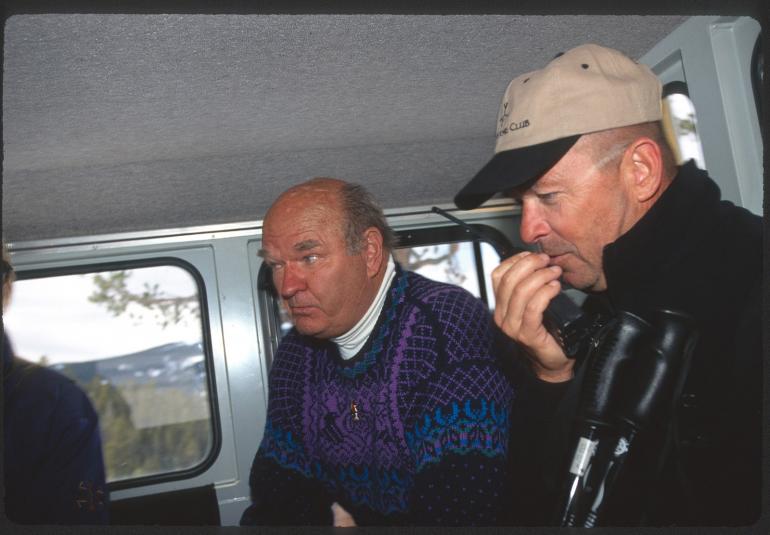History Repeating
In Big Sky, runaway development is putting the Gallatin River at risk. Here’s how one local law firm is holding today’s Copper Kings accountable.
Two security guards barked into their walkie-talkies and watched helplessly from a bridge as Isaac and I walked below them and out of the heart of the Yellowstone Club. Montana has some of the strongest stream-access laws in the United States, and we were putting them to the test. By staying below the high-water mark, we stumbled, slipped, and fell into the water for hours before reaching our destination: the place where an unnamed stream enters the South Fork of the Gallatin River. The stream begins on the Yellowstone Club’s golf course and holds one of the keys to Big Sky’s future. Isaac collected the water samples and we began our return, my running shoes desperately trying to grip the algae-covered rocks.
With a lodge sitting at more than 7,000 feet in elevation, the Yellowstone Club has taken Butte’s title as the richest hill on Earth. Like Butte, the Yellowstone Club has a history steeped in power, corruption, and greed. Tim Blixseth, Big Sky’s original Copper King, graduated from high school while working for a timber mill. He went on to wheel and deal as a timber baron, using land swaps and real-estate development to amass a fortune and begin the Yellowstone Club. Blixseth eventually went to jail, and his bankrupt Yellowstone Club was sold to CrossHarbor Capital Partners, an East Coast investment firm. A few years later, CrossHarbor would purchase the neighboring Spanish Peaks Resort, also in bankruptcy. After the bankruptcy bidding on Spanish Peaks ended, the seller described Sam Byrne, a founder of CrossHarbor, as the “new king of the valley.” Today, the emperor has no clothes.
Some people have written Big Sky off as a lost cause—a playground for the rich and a sacrifice zone for the environment. On any given day, a person can find candy wrappers covered in bear scat on the golf courses, or read about bears being euthanized for getting into buildings. Empty vacation homes displace wildlife, and the Montana Department of Environmental Quality (DEQ) has placed the tributaries of the Gallatin River on the 303(d) list of water-quality impaired streams. While most towns across the United States have a permit to discharge their treated wastewater into the nearest stream, the Yellowstone Club and Spanish Peaks do not, because the South and Middle Forks of the Gallatin River are water-quality impaired. Because no Clean Water Act permit is available to discharge into these waterways, the Yellowstone Club must ensure that it’s not over-irrigating its golf course with treated sewage. Two weeks after we collected our water sample from the stream coming off the golf course, the lab results revealed that treated sewage is reaching the South Fork. Our firm, Cottonwood Environmental Law Center, sent the Yellowstone Club a Notice of Intent to Sue.
Big Sky, Spanish Peaks, and the Yellowstone Club are now one large company town. The local newspaper is owned by a real-estate developer, who sits on the board of directors of the town’s most influential local conservation organization. For a long time, development has driven the local economy, and business has been good. With more and more people buying a slice of heaven, they are learning the painful lesson that growth comes at a price. As unbridled development has been allowed to run amok, the Gallatin River has run green with algae blooms. Most conservation groups in the area have been fearful to call out CrossHarbor and development in Big Sky at large as the sources of the algae blooms. They do not want to bite the hand that feeds them. While many are ignoring the elephant in the room, water sampling shows that the golf courses are being over-irrigated with so much treated sewage that it is draining into streams and, ultimately, the Gallatin River. The cold hard truth is that the Gallatin—and the Big Sky / Bozeman area more broadly—is being destroyed by overconsumption. We cannot buy our way out of this. Big Sky’s existing sewage-disposal problems aren’t going away with the current system, and new ones are appearing all the time.
While many are ignoring the elephant in the room, water sampling shows that the golf courses are being over-irrigated with so much treated sewage that it is draining into streams and, ultimately, the Gallatin River.
The agency in charge of regulating Big Sky’s polluters has been captured by the money and industries it is supposed to regulate. Last year, the Montana DEQ issued the Yellowstone Club a permit to make snow using treated sewage. The snow pollution will be blown onto Eglise Mountain—a French word that means “Church.” The Yellowstone Club touted its collaborative work with both local and national conservation groups as an exciting and innovative new approach to solving problems. But the proof is in the pudding, and the pollution continued. So Cottonwood Law, along with another small, local organization, filed a lawsuit challenging the pharmaceutical snow-making.
Wastewater-treatment plants do not remove pharmaceuticals from sewage. The Montana DEQ never disclosed the impacts of the Yellowstone Club blowing pharmaceutical snow pollution on Church Mountain, the snow melting, and the effects pharmaceuticals have on humans, fish, wildlife, and plants. Instead, the state agency told the public there would be no significant impacts from making snow using the treated wastewater, despite having science in its possession that documents amphibians changing sexes because of exposure to pharmaceuticals. The DEQ did not disclose concerns from the EPA about the impacts of pharmaceuticals on humans.
During the summer of 2021. Cottonwood Law placed a fluorescent tracer-dye in the treated sewage holding ponds of the Big Sky Water & Sewer District. The dye was found in the West Fork of the Gallatin River 26.5 hours later, proving that the liners are ripped. A senior engineer for the Montana DEQ provided expert testimony during a jury trial that the holding-pond liners need to be replaced if they are ripped. The Montana DEQ has still not required the Water & Sewer District to repair the torn liners. An attorney for the DEQ said the 29-year DEQ veteran engineer was not speaking for the agency during his testimony. Meanwhile, the Water & Sewer District continues to accept new sewer hook-ups from houses and developments. The Water & Sewer District is a quasi-governmental agency. Its board consists of real-estate developers.
In 2013, the outdoor-clothing company Patagonia published a story of mine in its winter catalog. It was about living in a yurt outside of Bozeman, without electricity or running water, while working in court to invalidate the construction permit for a coal railroad in southeast Montana. About a week after the catalog was mailed, I received a cryptic message from a guy that claimed to be working for the Yellowstone Club. The guy, let’s call him Slade, was interested in my thoughts on making the Yellowstone Club more environmentally sustainable. After a few meetings, Slade talked to me about working for the Yellowstone Club. One part of me felt like I’d be selling out, the other part of me was tired of being cold and poor. Ultimately, I brought a sleeping bag into the office and worked more hours.
Big Sky continues to grow into an incestuous pig sty. David Brower, the former head of the Sierra Club, once said, “I’d like to declare open season on developers. Not kill them, just tranquilize them.” He was being facetious, of course, but the sentiment is sound: as with many other imperiled ecosystems, what’s needed to clean up the Gallatin River is nothing less than a complete moratorium on development. This wouldn’t be the first time that development in Big Sky has paused. The Montana Department of Health and Human Services—the DEQ’s predecessor—placed a moratorium on construction in 1993, because the sewage holding ponds were leaking.
A Gallatin County Sheriff was waiting for Isaac and me when we got back to the truck. He said that he drove up from West Yellowstone after the Yellowstone Club reported us trespassing. After we assured him that we’d stayed below the high-water mark, he ran our plates, drivers’ licenses, and fishing tags, then thanked us for our work.
Despite the new Copper Kings amassing their absurd and incomprehensible wealth at the expense of the environment, there are still plenty of good guys on the ground, in Big Sky and in nearby towns. Which means that the Gallatin River is going to be okay—so long as we keep fighting the good fight.
John Meyer is the executive director of Cottonwood Environmental Law Center. He is the first person in his family to graduate from college and currently serves as the Chair of the Natural Resources, Energy, and Environmental Law section of the State Bar of Montana. He has been permanently banned from all property owned by Big Sky Resort.
High Country News also covered this issue in its 1997 article "Big Sky, Big Mess in Montana".
To help Cottonwood hold the Yellowstone Club's feet to the fire, donate to their current fundraising campaign.






